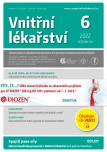What is a risk heart rate at various stages of the cardiovascular continuum?
Authors:
Anna Vachulová
Authors‘ workplace:
Kardiologická klinika Lekárskej fakulty UK a Národného ústavu srdcových a cievnych chorôb, a. s., Bratislava
Published in:
Vnitř Lék 2022; 68(6): 387-392
Category:
Review Articles
doi:
https://doi.org/10.36290/vnl.2022.079
Overview
Prevention, detection, and treatment of high blood pressure remain an important public health challenge. There is convincing evidence that heart rate is an important risk factor for cardiovascular disease. Recommendations for the resting heart rate measurement are roughly the same as those used for blood pressure measurement which is usually made during the same session. Across different parts of the cardiovascular disease continuum, different heart rate thresholds are identified. Elevated heart rate identifies patients with hypertension at high cardiovascular risk. One of the important causes of inadequate blood pressure control and at the same time heart rate control is the poor adherence of patients to treatment. It is necessary to individualize the treatment of patients with elevated heart rates throughout the cardiovascular continuum. Fixed-dose combination decreases the risk of medication non-compliance and should be considered in patients with chronic conditions like hypertension for improving medication compliance which can translate into better clinical outcomes.
Keywords:
heart rate – arterial hypertension – treatment adherence – fixed drug combinations
Sources
1. Williams B, Mancia G, Spiering W et al. ESC Scientific Document Group. 2018 ESC/ESH guidelines for the management of arterial hypertension Eur Heart J. 2018; 39 : 3021-3104.
2. Palatini P, Rosei EA, Casiglia E et al. Management of the hypertensive patient with elevated heart rate: Statement of the Second Consensus Conference endorsed by the European Society of Hypertension. J Hypertens. 2016 May;34(5):813-21. doi: 10.1097/HJH.0000000000000865
3. Hindricks G, Potpara T, Dagres N et al. ESC Scientific Document Group. 2020 ESC Guidelines for the diagnosis and management of atrial fibrillation developed in collaboration with the European Association for Cardio‑Thoracic Surgery (EACTS): The Task Force for the diagnosis and management of atrial fibrillation of the European Society of Cardiology (ESC) Developed with the special contribution of the European Heart Rhythm Association (EHRA) of the ESC. Eur Heart J. 2021 Feb 1;42(5):373-498. doi: 10.1093/eurheartj/ehaa612. Erratum in: Eur Heart J. 2021 Feb 1;42(5):507.
4. Archangelidi O, Pujades‑Rodriguez M, Timmis A et al. Clinically recorded heart rate and incidence of 12 coronary, cardiac, cerebrovascular and peripheral arterial diseases in 233,970 men and women: A linked electronic health record study. Eur J Prev Cardiol. 2018 Sep; 25(14):1485 - 1495. doi: 10.1177/2047487318785228.
5. Kolloch R, Legler UF, Champion A et al Impact of resting heart rate on outcomes in hypertensive patients with coronary artery disease: findings from the INternational VErapamil‑SR/ trandolapril STudy (INVEST). Eur Heart J. 2008 May;29(10):1327-34. doi: 10.1093/eurheartj/ehn123.
6. Knuuti J, Wijns W, Saraste A et al. ESC Scientific Document Group. 2019 ESC Guidelines for the diagnosis and management of chronic coronary syndromes. Eur Heart J. 2020 Jan 14;41(3):407-477. doi: 10.1093/eurheartj/ehz425.
7. Diaz A, Bourassa MG, Guertin MC et al. Long‑term prognostic value of resting heart rate in patients with suspected or proven coronary artery disease. Eur Heart J. 2005 May;26(10):967 - 74. doi: 10.1093/eurheartj/ehi190.
8. Murín J, Kamenský G et al. Register CLARIFY – pohľad na slovenské údaje po piatich rokoch. Cardiology Letters 2017;26(4):236-246.
9. Böhm M, Swedberg K, Komajda M et al. Heart rate as a risk factor in chronic heart failure (SHIFT): the association between heart rate and outcomes in a randomised placebo‑controlled trial. Lancet. 2010 Sep 11;376(9744):886-94. doi: 10.1016/S0140-6736(10)61259-7. PMID: 20801495.
10. Eriksen‑Volnes T, Westheim A, Gullestad L et al. β‑Blocker Doses and Heart Rate in Patients with Heart Failure: Results from the National Norwegian Heart Failure Registry. Biomed Hub. 2020 Feb 21;5(1):9-18. doi: 10.1159/000505474
11. McDonagh TA, Metra M, Adamo M et al. 2021 ESC Guidelines for the diagnosis and treatment of acute and chronic heart failure. Eur Heart J. 2021 Sep 21;42(36):3599-3726. doi: 10.1093/eurheartj/ehab368.
12. Šimková A Výsledky DMTK u pacientov s artériovou hypertenziou v roku 2021, Medicus News 3/3021
13. Ceral J et al. Difficult‑to‑control arterial hypertension or uncooperative patients? The assessment of serum antihypertensive drug levels to differentiate non‑responsiveness from non‑adherence to recommended therapy. Hypertension Research. 2011;34,87–90.
14. Naderi SH, Bestwick JP, Wald DS. Adherence to drugs that prevent cardiovascular disease: meta‑analysis on 376,162 patients. Am J Med. 2012 Sep;125(9):882-7.e1. doi: 10.1016/j.amjmed. 2011. 12. 013.
15. IQVIA DATA, 2020
16. Thomopoulos C, Bazoukis G, Tsioufis C, Mancia G. Beta‑blockers in hypertension: overview and meta‑analysis of randomized outcome trials. J Hypertens. 2020; 38(9):1669-1681.
17. Lutai MI et al. Ukrainian Cardiology Magazine. 2019;26(1):13-2.
18. Yamashita T, Ikeda T, Akita Y. Comparison of heart rate reduction effect and safety between bisoprolol transdermal patch and bisoprolol fumarate oral formulation in Japanese patients with persistent/permanent atrial fibrillation (BISONO‑AF study). J Cardiol. 2019 May;73(5):386 - 393. doi: 10.1016/j.jjcc.2018. 11. 009.
19. Nedogoda SV, Ledyaeva AA, Chumachok EV et al. Randomized trial of perindopril, enalapril, losartan and telmisartan in overweight or obese patients with hypertension. Clin Drug Investig. 2013 Aug;33(8):553-61. doi: 10.1007/s40261-013-0094-9.
20. Brugts JJ, Bertrand M, Remme W et al. The Treatment Effect of an ACE‑Inhibitor Based Regimen with Perindopril in Relation to Beta‑Blocker use in 29,463 Patients with Vascular Disease: a Combined Analysis of Individual Data of ADVANCE, EUROPA and PROGRESS Trials. Cardiovasc Drugs Ther. 2017 Aug;31(4):391-400. doi: 10.1007/s10557-017-6747-9.
Labels
Diabetology Endocrinology Internal medicineArticle was published in
Internal Medicine

2022 Issue 6
Most read in this issue
- Early gastric cancer
- Endoscopic treatment of early colorectal cancer
- Comprehensive approach to a patient with arterial hypertension and dyslipidemia
- Current trends in the diagnosis of pancreatic cancer
